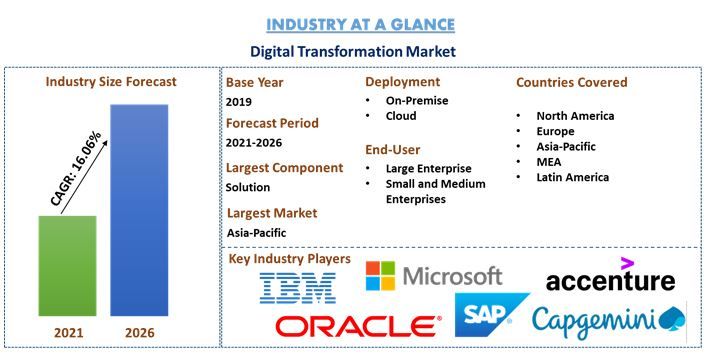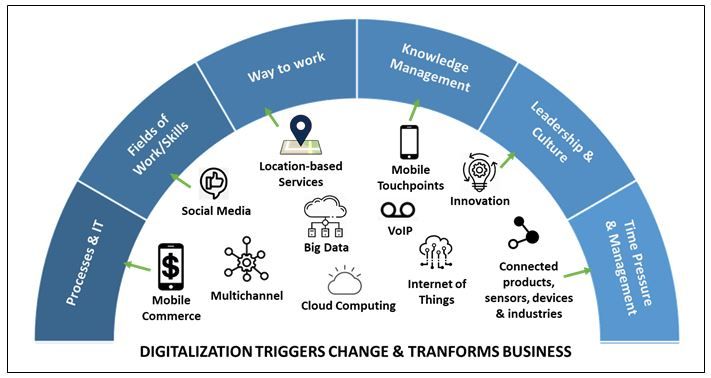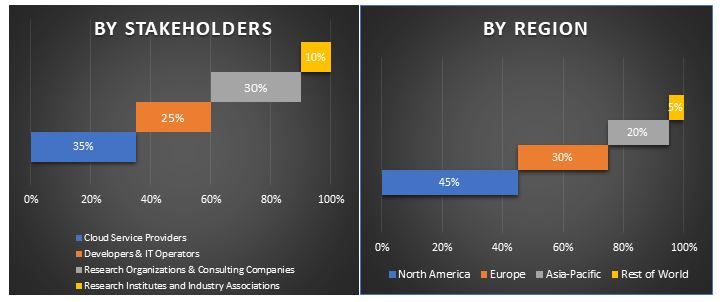- Home
- About Us
- Industry
- Services
- Reading
- Contact Us
Global Digital Transformation Market: Current Analysis and Forecast (2020-2026)
Emphasis on Component [Solutions (Cloud Computing, Big Data & Analytics, Mobility, Disruptive Technology, Social Media); Services (Professional Services, System Integration)]; by Deployment Type (On-Premises, Cloud); by End-User (Large Enterprises, Small and Medium Enterprises); Industry Verticals (BFSI, Government, Healthcare, Telecom & IT, Automotive, Retail & Consumer Goods, Media & Entertainment, Manufacturing, Other industry) and Region & Country
Global Digital Transformation Market is expected to reach the market valuation of US$ 3,693.8 billion by 2026 expanding at a reasonable CAGR of 16.06% during the forecast period (2021-2026) from US$ 1,180 billion in 2019. Over the past decade, the global digital revolution has yielded numerous advancements including wireless internet, smartphones, e-commerce, and wearable technology. These innovations have become commonplace throughout the developed world and are increasingly visible in emerging markets. Digital transformation is happening at a rapid pace, and sooner than organizations might think, many of the technologies that companies currently consider to be emerging, such as artificial intelligence and machine learning, would be pervasive. Digitalization is the cause of large-scale and sweeping transformations across multiple aspects of business, providing unparalleled opportunities for value creation and capture, while also representing a major source of risk. The rapid advances in digital technology are redefining the society.
According to the study conducted by IDC, two-thirds of the global 2000 companies’ CEO are anticipated to shift their focus from traditional, offline strategies to modern digital strategies to improve the customer experience with approximately 34% of the organizations believing to fully adopt digital transformation within a year. In 2018, the net global spending on the digital transformation was approximately US$ 1 trillion and is anticipated to increase to over US$ 2 trillion by 2022. Most of the digital transformations are driven by growth opportunities, followed by increased competitive pressure and new regulatory standards. Companies that get significant value on their digital investments invest 33% more than other companies in technology, processes, operating models, and the ways of working that will drive their digital supremacy. On average, higher-maturity organizations’ digital transformation efforts are twice as broad as those at lower-maturity organizations (maturity is defined as the level of benefit derived from digital transformation efforts). Digital transformation is a top-down initiative, often led with a vision from the C-suite. CIOs and CEOs are most often reported as owning or sponsoring digital transformation initiatives – 28% and 23%, respectively.
Digitalization Triggers Change & Transforms Business
IBM Corporation, Cognizant, SAP SE, Dell, Microsoft Corporation, Adobe Systems Incorporated, Accenture PLC, Capgemini, Oracle Corporation and Google Inc are some of the prominent players operating in the global digital transformation market. Several M&A’s along with partnerships have been undertaken by these players to facilitate costumers with hi-tech and innovative products.
Insights Presented in the Report
“Amongst component, Solution segment holds the major share”
Based on component type, the market is fragmented into Solution, and Services. Solutions dominated the market with a share of 78.3% in 2019 and is expected to maintain its dominance during the forecast period owing to the automation of the processes that cuts down time, increases efficiency in operational processes and minimizing costs.
“Amongst solution type, cloud computing sub-segment dominated the market in 2019”
The solution segment is further subdivided into cloud computing, big data and analytics, mobility, disruptive technology and social media. Cloud computing dominated the market with a share of 38.4% in 2019 and is expected to maintain its dominance during the forecast period. However, Disruptive technology is anticipated to witness highest CAGR during the forecast period (2021-2026).
“Amongst service type, Solution segment is expected to dominate the market during the analyzed period”
Service segment is bifurcated into professional services and system integration subsegments. Professional services dominated the market with a share of 81.8% in 2019 and is expected to maintain its dominance during the forecast period. However, system integration is anticipated to witness highest CAGR during the analyzed period. Through an integrated infrastructure, the complexities of different business processes and applications are gone, instead replaced by a simple-to-use, unified environment. From allowing employees to spend less time on mundane data entry to sleeping safely at night due to better levels of security, a modernized IT environment provide endless rewards.
“Amongst deployment type, cloud dominated the market in 2019”
Based on the deployment type, the market is segmented into on-premises and cloud. In 2019, cloud accounted for 58.9% of market revenue share and dominated the market. As businesses begin to adapt their processes to a digital space, they require cost and work efficiency, elasticity agility and scalability. The cloud provides all these features. Businesses that implement cloud computing and digital transformation report enormous growth and improved efficiency. It enables them to stay relevant and thrive in a dynamic ecosystem. However, on-premises segment in anticipated to witness highest CAGR during the forecast period.
“Amongst end-user, large enterprises are expected to dominate the market during the analyzed period”
Based on the end-user, the market is fragmented into large enterprise and small and medium enterprises. In 2019, the large enterprise accounted for the maximum market share with 61.7% and is expected to be the leading segment of the digital transformation market during the forecast period. However, Small and Medium Enterprises Digital Transformation Market is expected to witness highest CAGR growth during the forecast period 2021-2026.
“Amongst industry verticals, Banking Financial Services & Insurance dominated the market in 2019”
Based on the industry vertical, the digital transformation market is fragmented banking, financial services & insurance (BFSI), healthcare, telecom & IT, automotive, education, retail & consumer goods, media & entertainment, manufacturing, government, and others. In the BFSI industry, digital transformation helps to make financial transactions speedy, secure, simple, and error-free. In 2019, BFSI accounted for 25.2% of market revenue share and dominated the market. However, healthcare segment in anticipated to witness highest CAGR during the forecast period.
“Asia-Pacific represents one of the largest markets of Digital Transformation market”
For a better understanding of the market dynamics of the digital transformation market, a detailed analysis was conducted for different regions across the globe including North America (US, Canada, Mexico, Rest of North America), Europe (Germany, UK, France, Italy, Spain, Russia, Rest of Europe), Asia-Pacific (China, Japan, India, Singapore, South Korea, Australia and Rest of Asia-Pacific), Latin America (Brazil, Argentina, Rest of Latin America) and MEA (United Arab Emirates, Kingdom of Saudi Arabia, Qatar, South Africa, Rest of MEA) has been conducted. Asia-Pacific dominated the market and generated revenue of US$ 427 billion in 2019 owing to the emergence of the region as mature and digitally ready boil down to culture. It seems that, finally, business culture across the world but particularly in the Asia Pacific region is about to pay dividends. With what seems a genuine obsession on meeting customer needs and by investing in technology, people and partnerships, Asia Pacific is poised to take its place as the digital leader.
Reasons to buy this report:
- The study includes market sizing and forecasting analysis validated by authenticated key industry experts
- The report presents a quick review of overall industry performance at one glance
- The report covers in-depth analysis of prominent industry peers with a primary focus on key business financials, product portfolio, expansion strategies, and recent developments
- Detailed examination of drivers, restraints, key trends, and opportunities prevailing in the industry
- The study comprehensively covers the market across different segments
- Deep dive regional level analysis of the industry
Customization Options:
The Digital Transformation Market can further be customized as per the requirement or any other market segment. Besides this, UMI understands that you may have your own business needs, hence feel free to connect with us to get a report that completely suits your requirements.
Table of Content
Analyzing the historical market, estimation of the current market, and forecasting the future market of the Global Digital Transformation Market were the three major steps undertaken to create and analyze the adoption of Digital Transformation across various industry verticals in major regions globally. Exhaustive secondary research was conducted to collect the historical market numbers and estimate the current market size. Secondly, to validate these insights, numerous findings and assumptions were taken into consideration. Moreover, exhaustive primary interviews were also conducted, with industry experts across the value chain of the digital transformation sector. Post assumption and validation of market numbers through primary interviews, we employed a top-down approach to forecast the complete market size. Thereafter, market breakdown and data triangulation methods were adopted to estimate and analyze the market size of segments and sub-segments the industry pertains to. Detailed methodology is explained below:
Analysis of Historical Market Size
Step 1: In-Depth Study of Secondary Sources:
Detail secondary study was conducted to obtain the historical market size of the Digital Transformation through company internal sources such as annual report & financial statements, performance presentations, press releases, etc., and external sources including journals, news & articles, government publications, competitor publications, sector reports, third-party database, and other credible publications.
Step 2: Market Segmentation:
After obtaining the historical market size of the Digital Transformation market, we conducted a detailed secondary analysis to gather historical market insights and share for different segments & sub-segments for major regions. Major segments included in the report as component, deployment type, end-user, and industry verticals. Further country-level analyses were conducted to evaluate the overall adoption of the Digital Transformation in that region.
Step 3: Factor Analysis:
After acquiring the historical market size of different segments and sub-segments, we conducted a detailed factor analysis to estimate the current market size of Digital Transformation. Further, we conducted factor analysis using dependent and independent variables such as growth of penetration of digital transformation across different industry, digitalizing business functions. A thorough analysis was conducted for demand and supply-side scenario considering top partnerships, merger and acquisition, business expansion, and product launches in the Digital Transformation industry across the globe.
Current Market Size Estimate & Forecast
Current Market Sizing: Based on actionable insights from the above 3 steps, we arrived at the current market size, key players in the Digital Transformation market, and market shares of the segments. All the required percentage shares split, and market breakdowns were determined using the above-mentioned secondary approach and were verified through primary interviews.
Estimation & Forecasting: For market estimation and forecast, weights were assigned to different factors including drivers & trends, restraints, and opportunities available for the stakeholders. After analyzing these factors, relevant forecasting techniques i.e. top-down approach was applied to arrive at the market forecast about 2026 for different segments and subsegments across the major markets globally. The research methodology adopted to estimate the market size encompasses:
- The industry’s market size, in terms of value (US$) and the adoption rate of Digital Transformation across the major markets
- All percentage shares, splits, and breakdowns of market segments and sub-segments
- Key players in the Digital Transformation market in terms of services offered. Also, the growth strategies adopted by these players to compete in the fast-growing market
Market Size and Share Validation
Primary Research: In-depth interviews were conducted with the Key Opinion Leaders (KOLs) including Top Level Executives (CXO/VPs, Sales Head, Marketing Head, Operational Head, and Regional Head, Country Head, etc.) across major regions. Primary research findings were then summarized, and statistical analysis was performed to prove the stated hypothesis. Inputs from primary research were consolidated with secondary findings, hence turning information into actionable insights.
Split of Primary Participants in Different Regions
Market Engineering
Data triangulation technique was employed to complete the overall market estimation and to arrive at precise statistical numbers of each segment and sub-segment of the Digital Transformation market. Data was split into several segments & sub-segments post studying various parameters and trends in the areas of component, deployment type, end-user, and industry verticals of the Digital Transformation market.
The main objective of the Digital Transformation Market Study
The current & future market trends of Digital Transformation were pinpointed in the study. Investors can gain strategic insights to base their discretion for investments from the qualitative and quantitative analysis performed in the study. Current and future market trends were determined the overall attractiveness of the market at a regional level, providing a platform for the industrial participant to exploit the untapped market to benefit as a first-mover advantage. Other quantitative goals of the studies include:
- Analyze the current and forecast market size of Digital Transformation in terms of value (US$). Also, analyze the current and forecast market size of different segments and sub-segments
- Segments in the study include areas of component, deployment type, end-user, and industry verticals
- Defined analysis of the regulatory framework for the Digital Transformation industry
- Analyze the value chain involved with the presence of various intermediaries, along with analyzing customer and competitor behaviors of the industry
- Analyze the current and forecast market size of the Digital Transformation for the major regions
- Major regions studied in the report include North America (the U.S., Canada, and Mexico), Europe (Germany, France, Italy, Spain, Russia, and United Kingdom), Asia-Pacific (China, Japan, India, South Korea, Singapore, and Australia), MEA (Kingdom of Saudi Arabia, United Arab Emirates, Qatar, South Africa), and Latin America (Brazil, Argentina)
- Company profiles of the Digital Transformation market players and the growth strategies adopted by them to sustain in the fast-growing market
- Deep dive regional level analysis of the industry
Related Reports
Customers who bought this item also bought













